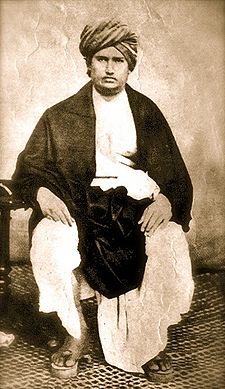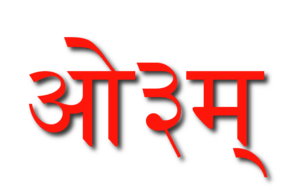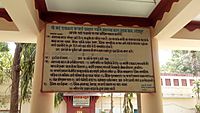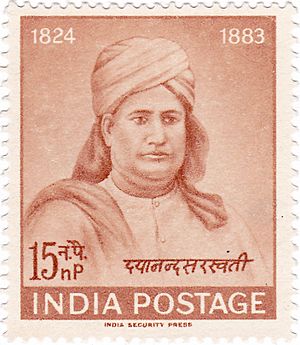Dayananda Saraswati facts for kids
Quick facts for kids Maharishi Dayanand Saraswati |
|
|---|---|
 |
|
| Birth Date | 12 February 1824 Jivapar Tankara, Morvi State, Company Raj (present-day Gujarat, India) |
| Died on | 30 October 1883 (aged 59) Ajmer, Ajmer-Merwara, British India (present-day Rajasthan, India) |
| Birth name | Mool Shankar Tiwari |
| Guru/teacher | Virajanand Dandeesha |
| Philosophy | Vedic |
Dayanand Saraswati (born Mula Shankar Tiwari; 12 February 1824 – 30 October 1883), also known as Maharshi Dayanand, was an Indian philosopher and social leader. He founded the Arya Samaj, a movement to reform the Vedic dharma. His most important book is Satyarth Prakash. This book explains the ideas of the Vedas and talks about human duties.
Dayanand Saraswati was the first to call for Swaraj (self-rule) in 1876. He said "India for Indians." Later, Lokmanya Tilak also used this idea. Dayanand Saraswati did not like idolatry (worshipping idols) or many old rituals. He wanted to bring back the original ideas of the Vedas. Important thinkers like S. Radhakrishnan and Sri Aurobindo called him a "maker of Modern India."
Many people were inspired by Dayanand Saraswati. These included Madam Cama, Swami Shraddhanand, Shyamji Krishna Varma, Vinayak Damodar Savarkar, Lala Hardayal, Ram Prasad Bismil, and Lala Lajpat Rai.
He was a sanyasi (a person who gives up worldly things) from a young age. He was also a great scholar. He believed that the Vedas held perfect and true knowledge. Dayananda taught about Karma (actions and their results) and Reincarnation (being born again). He also stressed the importance of brahmacharya (self-control), celibacy (not marrying), and devotion to God.
Dayananda Saraswati worked for equal rights for women. He believed women should have the right to education. He also thought they should be able to read Indian scriptures. He wrote explanations of the Vedas in Sanskrit and Hindi.
Contents
Early Life of Dayanand Saraswati
Dayananda Saraswati was born on 12 February 1824. His birth name was Mool Shankar Tiwari. He was born into a Hindu Brahmin family in Jivapar Tankara. This area is now part of Gujarat, India.
When he was eight, he had his Yajnopavita Sanskara ceremony. This marked the start of his formal education. His father was a follower of Shiva and taught him how to worship Shiva. He also learned the importance of fasting. One Shivratri night, Dayananda stayed awake to honor Shiva. He saw a mouse eating offerings and running over the idol. This made him wonder: if Shiva could not protect himself from a mouse, how could he protect the world?
Later, his younger sister and uncle died from cholera. These deaths made Dayananda think deeply about life and death. He started asking questions that worried his parents. He was engaged to be married when he was a teenager. But he decided marriage was not for him. So, he ran away from home in 1846.
Dayanand Saraswati spent about 25 years, from 1845 to 1869, as a ascetic. He traveled around, looking for religious truth. He gave up his belongings and lived a simple life. He focused on spiritual learning in forests, in the Himalayan Mountains, and at holy places in northern India. During this time, he practiced different types of yoga. He became a student of a religious teacher named Virajanand Dandeesha. Virajanand believed that Hinduism had moved away from its original path. He thought many practices had become impure. Dayananda Sarasvati promised Virajanand that he would dedicate his life to bringing back the true place of the Vedas in the Hindu faith.
Dayananda's Core Teachings
Maharshi Dayanand taught that all people can achieve anything. He said that all living beings are like eternal citizens of the Supreme Lord. He believed the four Vedas—Rigveda, Yajurveda, Samaveda, and Atharvaveda—are the only true sources of Dharma. He said these were revealed by the Supreme Lord at the start of every creation. They are perfectly preserved using Sanskrit prosody and chanting methods.
He thought confusion about the Vedas came from wrong interpretations. He said the Vedas support science and encourage people to find the Ultimate Truth. He stressed this in his writings on the Vedas.
He accepted the teachings of the first ten Principal Upanishads and the Shvetashvatara Upanishad. These texts explain the spiritual part of the Vedas. He also said that any other source, including Upanishads, should only be accepted if it matches the Vedas.
Dayanand accepted the six Vedanga texts. These include grammar and other tools needed to understand the Vedas correctly. For Sanskrit grammar, he said Pāṇini's Aṣṭādhyāyī and Patanjali's Mahabhashya are the only valid texts. He thought other modern grammar books were confusing and not helpful for learning the Vedas easily.
He also accepted all six Darshana Shastras. These include Samkhya, Vaisheshika, Nyaya, Yoga Sutras of Patanjali, Purva Mimamsa Sutras, and Vedanta sutras. Unlike other scholars, Dayanand said these six Darshanas are not against each other. Instead, each one explains a different important part of creation. He believed they are all independent and agree with the Vedas. He said that Acharya Kapila of Sankhya Darshan was not an atheist. He thought scholars had misunderstood his teachings.
He said that books like Aitareya Brahmana, Shatapatha Brahmana, and Gopatha Brahmana are also valid. These books were written by wise people to explain the Vedas. But he warned that they might have been changed by others. He said these books are called "Itihasa, Purana, Narashamsa, Kalpa, Gatha." They contain stories about wise people and world creation.
Dayanand Saraswati said that the eighteen Puranas and Upapuranas are not the true Puranas. He believed they were not written by sage Vyasa. He also said they go against the teachings of the Vedas and should not be accepted. He found these Puranas full of contradictions, idol worship, and rituals that go against the Vedas. In his book Satyarth Prakash, he wrote that any good parts in these Puranas are already in the Vedas. Since they contain too much false information, he said they should be rejected.
He explained that the name "Vyasa" for sage Veda Vyasa did not mean he divided the Vedas. Instead, it meant he had studied the Vedas very deeply.
He listed many texts that he thought were not honest guides to understanding the world and God. He rejected all Tantric texts including Pancharatra. He said these texts teach customs and rituals that are against the Vedas.
Maharshi Dayanand's teachings were based on the Vedas. Here are some main ideas:
- There are three eternal things: 1. The Supreme Lord (Paramatma), 2. Individual souls (Jivatmas), which are many but not endless, and 3. Nature (Prakriti).
- Prakṛti (Nature) is the material from which the world is made. It is eternal and has three qualities: Sattva, Rajas, and Tamas. These qualities usually stay balanced. In each creation cycle, the Supreme Lord disturbs this balance. This makes nature useful for creating worlds and bodies for individual souls. After a very long time, called the day of Brahma, creation ends. Nature returns to its balanced state. After a period called the Night of Brahma, which is just as long, creation starts again. This cycle of creation and ending has no beginning or end.
- Jiva (individual eternal Soul) are many. They are different but can reach the same level of happiness in Moksha (Liberation). They are not made of natural particles and have no body. They are beyond all genders and worldly traits. But they get bodies made of nature based on their past actions. They work to improve themselves. By understanding themselves, nature, and the Supreme Lord, souls can become free. This freedom depends on their efforts and knowledge. They keep coming to the world, using nature, and getting results from their actions. They can take many forms of life. They are free to choose their actions, learn, and reach Liberation. After a very long time in Moksha, they come back to the world. Because Moksha is so long, it seems like they never return to others still in the world. Since souls are eternal and can work, their traits cannot be destroyed. They are timeless, eternal, but not all-knowing. So, they cannot be everywhere in space.
- The Supreme Lord is one and has no equal. His name is Om. He is the main cause of the Universe. The Lord's main qualities are Sat (exists), Chit (has Supreme Consciousness), and Ananda (is eternally Blissful). The Lord and His qualities are the same. The Supreme Lord is always everywhere. His qualities are beyond Nature and individual souls. He is present in all souls and in Nature. It is not the Lord's nature to be born or take a physical form. He is always pure, not mixed with traits of Nature or souls. The Supreme Lord has no body, is infinite, and has no form. So, He cannot be worshipped through idols. He can only be reached through Yogic Samadhi, as taught in the Vedas and summarized in the Yoga Sutras of Patanjali. Since the Lord has no body and is beyond gender, the Vedas call Him Father, Mother, Friend, and Creator of the Worlds. He is the subtlest being, even subtler than Nature. He fills all existence and space. Because of His subtlety, He can use Nature to create worlds. He does not stop the movement of worlds in space. So, He is called Paramatman, meaning 'Ultimate Pervader'. No one is equal to Him or completely opposite to Him. Ideas of Satans, Ghosts, or Demons are not found in the Vedas.
- He said names like Agni, Shiva, Vishnu, Brahma, Prajapati, Paramatma, Vishva, and Vayu refer to different qualities of the Supreme Lord. The meaning of each name should come from its root word (Dhatupatha or Root (linguistics)). These names do not refer to the gods found in the Puranas that people worship. Also, some names might refer to worldly elements, which should be understood from their context.
- Maharshi Dayanand cleverly explained the idea of God having both Saguna (with qualities) and Nirguna (without qualities) characteristics. He said Saguna refers to qualities like being everywhere, all-powerful, blissful, and having ultimate consciousness. Nirguna refers to qualities that God does not have, like those of Nature or individual souls, such as different states of being or being born. Before his time, people thought 'Saguna' meant 'with form and body' and 'Nirguna' meant 'without form and body'.
- On Moksha (State of Liberation): Moksha is not a place. It is a state of individual souls who have achieved freedom. Souls have four states: 1. Jagrat (Wakefulness), 2. Swapna (Dreamy state), 3. Sushupti (Deep Sleep), and 4. Turiya. In the fourth Turiya state, souls exist without contact with Nature. They are aware of themselves, other souls, and the Supreme Lord. This state of Moksha or Turiya is not seen in the world and cannot be compared. It can only be experienced. In this state, souls are free from Nature. They have their own minds and feel bliss and the joy of freedom. This joy is greater than any worldly pleasure. In this state, they have no body. They can do anything they wish by their own will. For example, they can hear without needing physical ears. They can fulfill all their wishes and go anywhere instantly. They can see the creation, maintenance, and ending of worlds. They also meet other liberated souls. But even in this state, the power to create worlds stays with the Supreme Lord. In Moksha, individual souls remain separate from each other and from the Supreme Lord. They enjoy bliss using their own abilities and with the Supreme Lord as their guide. After a period of Moksha, they return to this World. He quoted verses from the Vedas and Mundakopanishad in his books Satyarth Prakash and Rigvedaadi Bhashya Bhumika to support this.
- Maharshi Dayanand also explained the idea of unending or eternal Moksha. He said 'Eternal Moksha' means the pleasures of Moksha are permanent, unlike the short-lived pleasures of the world. It does not mean souls stay in Moksha forever. He explained that souls are permanent, so their qualities are too. It is illogical to think a soul would be trapped in time and escape the world forever after a finite time of lives. He also said that actions done for a limited time cannot give endless results. After the Moksha period, souls would no longer be able to enjoy the bliss of Moksha. So, the Vedic teaching that souls return after liberation is correct.
These teachings, he said, are based on the Vedas and Upanishads.
Social Causes: He spoke out against the Caste system, Sati practice, idol worship, and child marriage. He said these were against the true spirit of the Vedas. He believed all bad things in society should be found and removed. He taught that the Varna system (social classes) should be based on education and profession. In his book Satyarth Prakash, he used texts like Manusmriti and Vedas to support this. He also supported the idea of a single government for the whole world, called Chakradhipatya.
Dayananda's Mission

Dayanand Saraswati believed that Hinduism had changed too much from the original ideas of the Vedas. He thought priests had misled people for their own gain. To fix this, he started the Arya Samaj. He created Ten Universal Principles for this movement. He wanted the whole world to be a home for "Aryas," meaning noble people.
His goal was to reform Hinduism and bring people back to God. He traveled around India, challenging religious scholars and priests to debates. He often won because of his strong arguments and deep knowledge of Sanskrit and the Vedas. Hindu priests often discouraged common people from reading Vedic scriptures. They encouraged rituals like bathing in the Ganges River and feeding priests on special days. Dayananda called these practices superstitions or selfish acts. He urged people to reject these ideas. His aim was to teach the nation to return to the Vedas' teachings and live a Vedic way of life. He also told Hindus to accept social changes. He emphasized the importance of cows for the country's wealth. He also promoted Hindi as the national language for unity. Through his life, yoga practice, teachings, and writings, he inspired Hindus to seek Swarajya (self-governance), nationalism, and spiritual growth. He fought for equal rights and respect for women. He also believed all children, boys and girls, should be educated.
Dayanand also looked closely at other faiths. These included Christianity, Islam, Jainism, Buddhism, and Sikhism. He was against idol worship in Hinduism. He also opposed what he saw as corruption of the true faith in India. Unlike other reform movements, the Arya Samaj aimed its message not just at educated Indians, but at the whole world. This is shown in the sixth principle of the Arya Samaj. His teachings promoted universal ideas for all living beings, not just for one group or nation.
The Arya Samaj welcomes and encourages people to convert to Hinduism.
Dayananda's Vedic message taught respect for other people. This was supported by the Vedic idea that every person has a divine nature. In the ten principles of the Arya Samaj, he wrote that "All actions should be performed with the prime objective of benefiting mankind." This was different from just following rituals or worshipping idols. The first five principles talk about Truth. The last five principles talk about a noble society, good manners, living together, and a disciplined life. In his own life, he saw moksha (personal liberation) as a lesser goal. He believed it was more important to help others become free.
Dayananda's message of "back to the Vedas" influenced many thinkers and philosophers worldwide.
Dayanand's Activities
Dayanand Saraswati was active from a young age. By 14, he could recite religious verses and teach about them. He was respected for taking part in religious debates. Many people came to watch his debates.
On 22 October 1869, in Varanasi, he won a debate against 27 scholars and 12 expert pandits. Over 50,000 people were said to have attended. The main topic was: "Do the Vedas support deity worship?"
Arya Samaj's Beliefs
Dayananda Saraswati founded the Arya Samaj. This group spoke out against many practices of different religions and communities. These included idol worship, animal sacrifice, pilgrimages, priest craft, temple offerings, the caste system, child marriages, meat eating, and discrimination against women. He argued that these practices went against common sense and the wisdom of the Vedas.
Dayananda's Views on Superstitions
He strongly criticized practices he saw as superstitions. These included sorcery and astrology, which were common in India at the time.
He clearly separated true Jyotisha Shaastra (the study of heavenly bodies) from astrology. He called astrology a fraud.
Dayananda's Views on Other Beliefs
Dayanand Saraswati believed that many popular religions had stories that were not moral. He also thought their practices were bad, or that they had moved too far from the Vedas. In his book Satyarth Prakash, he looked closely at the forms of Hinduism, Jainism, Buddhism, Christianity, and Islam of his time.
He believed that some religions promoted wars and bad behavior. He questioned why a God would hate non-believers or command the killing of innocent people or animals.
He also analyzed the Bible. He tried to compare it with scientific facts and moral ideas. He claimed the Bible had stories and rules that were immoral. He said it praised cruelty and encouraged sin. He pointed out what he saw as logical mistakes in the Bible. He argued that the Bible sometimes showed God acting like a human, not an all-knowing or perfect being.
He disagreed with the idea of the perpetual virginity of Mary. He said such ideas go against the laws of nature. He believed God would never break His own laws because God is all-knowing and perfect.
He also had strong views on Sikhism, Jainism, and Buddhism. He believed that some religious leaders were mistaken about the Vedas. He criticized stories that claimed miraculous powers for leaders. He thought some practices in these religions were against the Vedas or promoted ideas he disagreed with. For example, he described Buddhism as "anti-vedic" and "atheistic."
Attempts on Dayananda's Life
There were many attempts to kill Dayananda Saraswati, but they failed.
His followers said he was poisoned a few times. But because he regularly practiced Hatha Yoga, he survived these attempts. One story says attackers tried to drown him in a river. But Dayananda pulled them into the river instead. He let them go before they drowned.
Another story says Muslims attacked him while he was meditating on the Ganges river. They were upset by his criticism of Islam. They threw him into the water. But he was said to have saved himself because his pranayama practice allowed him to stay underwater until the attackers left.
Dayananda's Death
In 1883, the Maharaja of Jodhpur, Jaswant Singh II, invited Dayananda to stay at his palace. The Maharaja wanted to become Dayananda's student. During his stay, Dayananda saw the Maharaja with a dancing girl. Dayananda asked the Maharaja to leave the girl and stop all wrong actions. He told him to follow the dharma like a true noble person. This suggestion upset the dancing girl, Nanhi Jaan. She decided to get revenge.
On 29 September 1883, she paid Dayananda's cook, Jagannath. She told him to mix small pieces of glass into Dayananda's milk at night. Dayananda drank the milk. He became very sick for several days and felt terrible pain. The Maharaja quickly called doctors. But by the time they arrived, Dayananda's condition was much worse. He had large bleeding sores. When Jagannath saw Dayananda suffering, he felt very guilty. He told Dayananda what he had done. On his deathbed, Dayananda forgave the cook. He gave him money and told him to leave the kingdom quickly. He wanted Jagannath to escape before the Maharaja's men found and punished him.
Later, the Maharaja arranged for Dayananda to go to Mount Abu for better care. After some time there, on 26 October 1883, he was sent to Ajmer. But his health did not improve. He died on the morning of the Hindu festival of Diwali, on 30 October 1883. He was chanting mantras as he passed away.
Cremation and Remembrance
Dayananda Saraswati died at Bhinai Kothi, near Ajmer. His ashes were scattered in Rishi Udyan in Ajmer, as he wished. Rishi Udyan has an Arya Samaj temple. Daily morning and evening yajna homa (fire rituals) are held there. It is located by Ana Sagar Lake on the NH58 Ajmer-Pushkar Highway.
Every year, a three-day Arya Samaj melā (fair) is held at Rishi Udyan. This happens around Dayanand's death anniversary in late October. It includes Vedic seminars, Vedas memorization contests, yajna, and a Dhavaja Rohan flag march. The Paropkarini Sabha organizes it. This group was founded by Swami Dayanand Saraswati on 16 August 1880.
On Maha Shivaratri each year, Arya Samaj members celebrate Rishi Bodh Utsav. This is a two-day fair in Tankara. It includes a Shobha Yatra procession and a Maha Yajna. Important leaders like the Prime Minister of India, Narendra Modi, and the Chief Minister of Gujarat, Vijay Rupani, have attended this event.
The Navlakha Mahal in Gulab Bagh and Zoo at Udaipur is also connected to him. He wrote the second version of his important book, Satyarth Prakash, there in 1882-83 CE.
Dayananda's Legacy
Several institutions are named after him. These include Maharshi Dayanand University in Rohtak and Maharshi Dayanand Saraswati University in Ajmer. The DAV University (Dayanand Anglo-Vedic Schools System) in Jalandhar is also named for him. More than 800 schools and colleges are run by the D.A.V. College Managing Committee, including Dayanand College in Ajmer. Industrialist Nanji Kalidas Mehta built the Maharshi Dayanand Science College and named it after Dayananda Saraswati.
Dayananda Saraswati is most famous for influencing India's freedom movement. His ideas and writings inspired many leaders. These include Shyamji Krishna Varma, who founded India House in London. Other revolutionaries like Subhas Chandra Bose, Lala Lajpat Rai, Madam Cama, Vinayak Damodar Savarkar, Lala Hardayal, Ram Prasad Bismil, and Mahatma Hansraj were also influenced by him.
He also had a big impact on Bhagat Singh. After primary school, Singh joined the Dayanand Anglo Vedic Middle School in Lahore.
The places Dayanand visited often changed culturally. Jodhpur adopted Hindi as its main language, and later the entire state of Rajasthan did the same. Other admirers included Swami Vivekananda, Ramakrishna, Bipin Chandra Pal, Vallabhbhai Patel, and Romain Rolland. They saw Dayananda as a remarkable and unique person.
American Spiritualist Andrew Jackson Davis called Dayanand a "Son of God." He praised Dayanand for helping India regain its status. Sten Konow, a Swedish scholar, noted that Dayanand helped revive India's history.
Other notable people influenced by him include Ninian Smart and Benjamin Walker.
Dayananda's Writings
Dayananda Saraswati wrote over 60 works. These include a 16-volume explanation of the six Vedangas. He also wrote an unfinished commentary on the Ashtadhyayi (Panini's grammar). He wrote several smaller books on ethics, morality, Vedic rituals, and sacraments. He also analyzed other beliefs like Advaita Vedanta, Islam, and Christianity. Some of his major works are Satyarth Prakash, Satyarth Bhumika, Sanskarvidhi, Rigvedadi Bhashya Bhumika, Rigved Bhashyam, and Yajurved Bhashyam. The Paropakarini Sabha in Ajmer was founded by Saraswati. Its purpose was to publish and spread his works and Vedic texts. He was an important social and religious reformer in 19th-century India.
List of Works
|
|
|
See Also
 In Spanish: Dayananda Sarasvati para niños
In Spanish: Dayananda Sarasvati para niños
- Cow protection movement
- Swami Shraddhanand
- Sudhakar Chaturvedi



